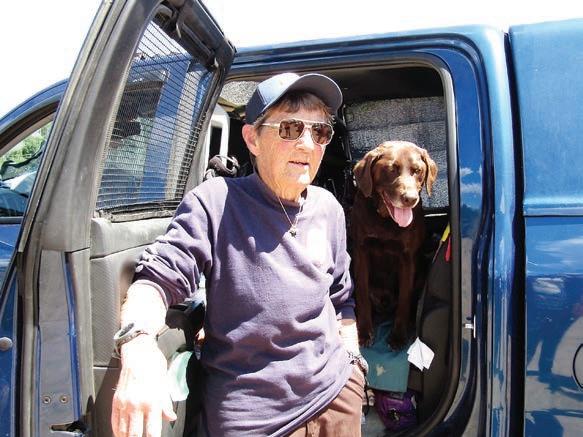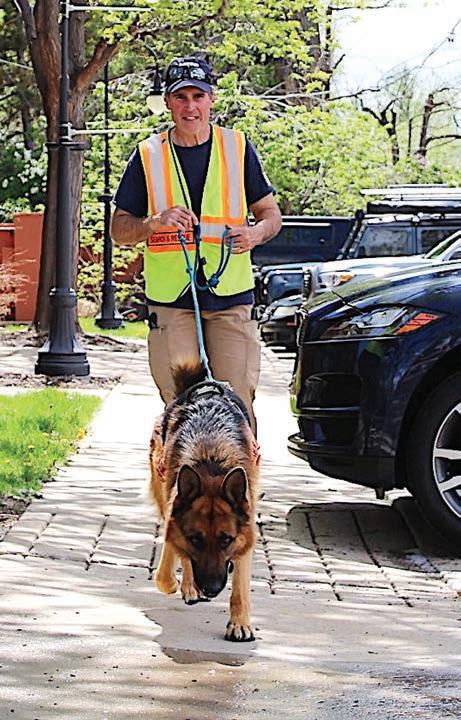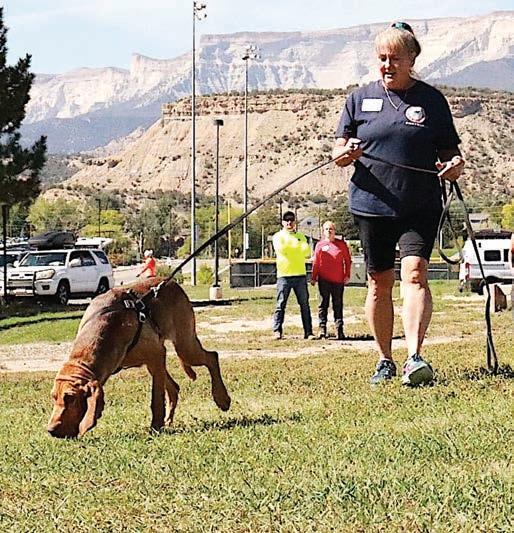
10 minute read
NORTON
FROM PAGE to be the center of attention, we all eagerly wrote our messages of love, a ection, and appreciation. And as we all read our note, the consistency was unreal; Jill was light, love, passionate, determined, a role model of success, bright, beautiful, and someone who exuded the desire to help others.




Why am I sharing this story? Sadly, Jill passed away suddenly last month. Her beautiful smile to never grace this earth again, but that will bless the halls of heaven for eternity. ose of us who knew her well, knew all sides of Jill as we had three plus years to share calls, Zoom calls, webinars, texts, and emails. Some of us got to see her and be with her since we graduated ZLC23. And there wasn’t any one of us who didn’t appreciate her e orts to worry more about us and how we were doing than how she was personally doing herself. As the news hit our ZLC23 class, we reached out to one another for comfort and understanding; it’s one of the things that happen when you become Ziglar certi ed and connect with your classmates, you graduate as di erence makers in the personal, professional, and spiritual lives of everyone you have the opportunity air quality and soil contamination on the site.
Kozacek spoke of the referendum during public comment at the April 17 city council meeting, and Mayor Pro Tem Steven Ward spoke in recognition of the public’s right to challenge the council’s decision.
“ e referendum is the way to handle this. I have to say, I’m proud of you. I cast a vote for the Sam’s Automotive development and I did it — I explained it at the time — I did it because I felt that was what my legal obligation was,” Ward said. “As citizens, because that’s done by ordinance, the people have a right to challenge that decision, and that’s what’s happening right now.” e referendum petition states that those who signed it are protesting the ordinance that approved the planned unit development.
“ e right to direct democracy is something that I value deeply, particularly on a local level because sometimes the body does step in poop and the citizens need an opportunity to tell us that we have,” he added.
It states, “By signing this petition, you are protesting this ordinance going into e ect and — if su cient signatures are obtained — causing Englewood City Council to reconsider this ordinance, by either repealing it in full or calling a special election to submit it to a vote of the electors of this city.” e referendum petition needed at least 1,466 signatures of Englewood registered electors by May 4. e city announced in a June 6 news release that the city clerk’s o ce to meet. And Jill epitomized that mission and purpose, she changed us all. Even when she was going through life’s challenges herself, she was the rst one to respond to a prayer request, jump into a conversation, or ask a meaningful question during a podcast or webinar. determined the petition “to be valid and su cient.”
Jill was a di erence maker.
I write this column as a tribute to Jill, a true ZLC’er class of ‘23. I write this to remind us that we all have something to give to others regardless of how short or long our lives here on earth are. We can smile, be kind, show our passion, know our purpose, and simply care about the person sitting across from us in the moment, because that is who Jill was, a living example to us all.
Is there someone who you need to tell how awesome they are before they are gone? Did this tribute connect with you? I would love to hear your story at gotonorton@gmail. com, and when we can remember those who left their ngerprints of love and light on our lives, it really will be a better than good life.
Michael Norton is an author, a personal and professional coach, consultant, trainer, encourager and motivator of individuals and businesses, working with organizations and associations across multiple industries.
“I’ll start o by thanking all the people that helped support the referendum. It has been successful,” Kozacek said during public comment at the June 5 city council meeting. “We hit every neighborhood.”
Next steps
According to the news release, voters who wish to protest the validity of the referendum petition have until June 13 to le their opposition. If a protest is led, a hearing would be scheduled to make a nal determination of the validity of the petition.
If no protest is received, the referendum petition will be presented to the council during its June 20 regular meeting.
e council members will then decide whether to repeal the ordinance or have Englewood residents vote on the matter at the next general municipal election, which will be in November, unless the city decides to hold a special election sooner. e city said in the news release that the petitions are available to the public for inspection, and if residents have questions or would like to le a protest, they should call the clerk’s o ce at 303-762-2430.
A special election would cost roughly $80,000, said Englewood City Attorney Tamara Niles during the June 5 city council meeting.
“It would be our recommendation that unless there’s another special election scheduled, that we just put this on the general (election in November) so that it doesn’t cost the city any money out of pocket,” Niles said.
If the planned unit development is repealed, then the subdivision ordinance that would combine the three property lots would also be repealed, as determined during the June 5 meeting.
“Essentially, if there’s no PUD (planned unit development), there’s no need for the subdivision,” Niles said.







BY DEB HURLEY BROBST DBROBST@COLORADOCOMMUNITYMEDIA.COM
Search-and-rescue dogs embody the mail carrier motto: “Neither snow, nor rain nor gloom of night” will keep these trusty canines from their appointed rounds — searching for people or items with single-minded purpose.
For the dogs and their trainers who are part of the Colorado branch of SARDUS — Search and Rescue Dogs of the United States — training is a weekly, if not daily, endeavor to prepare dogs to certify in an area of search and rescue or to keep the dog’s skills sharp after certi cation.
“ e training continues for life,” said Cathy Bryarly, a retired Boulder sheri ’s deputy who trains search-and-rescue dogs. “ is has to be part of your life. It goes way beyond a hobby, or it’s not going to work. It’s a calling.”
SARDUS members agree that it’s a labor a love based in their strong resolve to help others. Not only do the dogs and their handlers train multiple times a week, enlisting family and friends to hide, so the dogs have someone to search for, but handlers also attend seminars on a variety of topics and work together by laying trails for others to follow.
Trainers are always learning, so they can improve their canines’ ability to help in emergency situations.
Search-and-rescue dogs and their handlers are not paid; in fact, handlers spend a lot on the dogs, the equipment, the training and more. e goal is to be certi ed to go on missions, the term for helping law enforcement nd people, bodies or objects needed in an investigation.
Call the people trainers or handlers, but more importantly, they’re dog lovers who want to work as a team with their pets to help others.
The humility of training e trainers say it simply: Training their canines is humbling.
“Our dogs don’t make the mistakes,” Anjie Julseth-Crosby of Morrison said. “We do. ere’s so much to remember. e training is about me trying to understand what (the dogs) are saying. e human fails, not the dog.”
In fact, Julseth-Crosby, who started training her bloodhounds two years ago, has compiled a 19-page document called “ ings I wish I knew two years ago.”
Training involves having a dog follow a scent for several miles, helping the dog return to the SEE DOGS, P15 scent trail if needed and rewarding the dog when it nds the person or item it is directed to follow. food or toys. Once you gure that out, then trainers must convince the dog to do what they want the pup to do for the reward. It begins with what is called a puppy run-away, where you get the pup to run after a person, and when the pup nds the person, the pup gets a reward. at transitions to following a scent to nd a person.
Training can be messy as canines follow the scent wherever it takes them over all sorts of terrain in all kinds of weather.
“It’s just a matter of making it harder and harder to the point where a dog is searching 120 acres for one person or that trailing dog is following a 24-hour-old scent through a subdivision,” Bryarly said.


No matter what or who the dog is nding, it must go to it, stay there, lay down and point its nose, so the handler knows the dog is saying that the item or person is there.
Dogs cannot certify to be search-and-rescue dogs until they are at least 18 months old, but it usually takes two years or more for the rst certi cation, Bryarly said.
“Search-and-rescue dogs that are out in the public have to be just perfect,” Bryarly said. “ ey have to stay focused and not get distracted by other dogs, animals or people.”
Getting involved irty years ago, Julseth-Crosby made a pledge that she would own a bloodhound and train it to be a search-and-rescue dog. at’s because Ali Berelez, 6, who had been kidnapped and murdered in 1993, was found four days after her abduction by bloodhound Yogi. a multiple-day-a-week job.
Julseth, at that time a single parent with a 6-yearold, felt kinship with Ali’s family. However, as a full-time teacher, Julseth-Crosby decided to wait to train when she retired in 2021. True to her word, she began training her bloodhounds Bruno and Miley.
Niamh Coleman of Nederland was looking for something to do with her dogs, thinking it was a casual pastime. Now search-and-rescue dog training is closer to an obsession.
Jayne Zmijewski, who taught outdoor skills to rangers most of her life, said search-and-rescue dogs were a natural progression. She’s had four search-and-rescue dogs in the last 30 years, most recently her chocolate Labrador Kodi.

Teresa Verplanck of Bailey is training Lilo, a border collie mix, for wilderness searches. She called the SARDUS group she trains with wonderful, and trainers and dogs have become a big family.
Jake Udel, who lives near Rustic, Colorado, is a volunteer firefighter and medic, and he trains his dog, Java the Mutt, a Czech shepherd, “for the love of dogs, helping people and the activity.”
Julseth-Crosby said the number of hours can be whatever trainers can put in, but at a minimum eight hours a week, and some weeks, she trains or prepares for training as much as 40 hours a week.
The right breed
While just about any breed of dog can become a search-and-rescue dog, bloodhounds, shepherds and retrievers are the typical dogs people think of, but other breeds — if they have the nose for the work — can be certi ed.
“It works better to start with a breed that is bred to do this,” Bryarly said. “In fact, there are some breeders who breed speci cally search-and-rescue dogs. But sometimes you nd a dog that is good at this, and it’s a breed you never would have guessed could do this work.” e most important thing, Bryarly said, is the bond that the dog and handler have with each other.
“People have told me over the years that they are amazed at something their dog does,” she said. “People think they are the smart ones, but the dog is the smart one. We are just trying to keep up with them.”
Starting early
Training starts early — when pups are a few weeks old.
“Start with a dog who has a high drive,” Bryarly said. “A high-drive dog is always busy and always wanting something to do. If that energy is not channeled right away, the pup will tear your house apart.”
Most canines prefer one of two types of rewards:
Types Of Sardus Certifications

Melanie Weaver of Lafayette knew her dog, Lego,
Udel figures he’s been on 75 to 100 missions since he certified his first dog in 2005.

SARDUS a German shepherd, needed a job to have a ful lling life, and Weaver was looking for something practical. Little did she know that training Lego would be
SARDUS, one of several search-and-rescue dog organizations in the country, helps smaller organizations test and certify dogs. To get the trailing or air-scent certification, which is usually the first certification a dog earns, the canine must follow a 24-hour-old trail to find a person. SARDUS only works with law enforcement, so a person cannot request a search-andrescue dog.
Bryarly said about 30 dogs in Colorado are certified by SARDUS with most of them trailing dogs — the most of any organization in the country.
Membership in SARDUS is $25, and some people join who don’t own dogs, but they want to help in other ways such as creating tracking trails or hiding from dogs, Bryarly said.
Trainers must be physically fit since they follow their dogs through all sorts of terrain, plus they take classes such as the Federal Emergency Management Agency’s incident command courses, so they understand the structure of incidents and managing evidence.

For the SARDUS trainers, the work is definitely a passion.
• Trailing: Dogs who can find scents by putting their noses to the ground.
• Air scenting: Dogs who find scents by putting their noses into the air.
• Avalanche: Some dogs are good at smelling human scents through snow.
• Water: Some dogs are good at smelling human scents through water.
“If you think of it as work, you won’t do it for 20 years,” Udel explained. “You have to adopt the (search-and-rescue) lifestyle. It’s a life-anddeath commitment for some people — certainly the people we are looking for.”
• Disaster search: Dogs can smell through debris to find people.
• Human remains: Dogs can be certified to find human remains.
• Wilderness: A type of trailing in remote areas.







